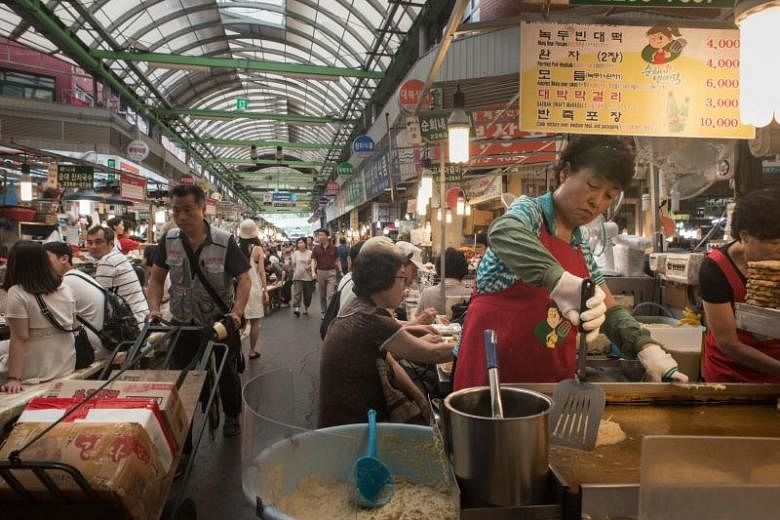(THE STAR/ASIA NEWS NETWORK) - It's no secret that travel is getting more expensive with the increasing prices of goods and services, such as transport, accommodation and food, among other things, on top of the unfavourable foreign currency exchange rates.
But, the good news is, it's still possible to travel on a budget.
If you are headed to Seoul, here are some ways to better enjoy your time and also lighten your budget.
1. Card it all the way
We're not referring to credit cards, but transportation cards. Don't be afraid to take public transport because it is a lot more convenient than it sounds. If you buy the T-money card (Korea Transportation Card) or Cashbee card, it can take you on all modes of public transport such as buses, subways and even some taxis.
These transportation cards are easily available at convenience stores, including CU, GS25, 7-Eleven, Ministop, With Me, Buy The Way and Story Way. T-money cards are also available from ticket-vending and card-reload machines inside subway stations. They can be easily topped-up at these locations.
They can be used not just in Seoul, but also other metropolitan cities and locations throughout South Korea. Besides enjoying discounts on rides during transfers from bus to bus, subway to subway, bus to subway, or subway to bus (within a transfer time limit), you'll also save yourself the hassle of having to purchase a single-journey subway ticket for every ride.
You can easily pick up a transportation card when you arrive at the airport (at one of the convenience stores). When it's time to fly back home, just return it for a refund on the balance. Or, you might even want to keep the card, as some of them have unique designs (especially the limited-edition ones) and make good souvenirs.
2. Language
Learning a new language is never a waste and you never know when it will come in handy. Korea Plaza in Menara Hap Seng Kuala Lumpur offers free Korean language classes, but registration is required.
If you prefer self-learning rather than learning in a classroom setting, you can use your spare time while waiting or commuting to listen to language tapes, or even play them while you drive.
Practice makes perfect, and there are Facebook communities where you can learn the Korean language together with others in an online community. And you get to practice what you've learnt in Seoul.
3. Homestays and Backpackers' hostels
Hotels in South Korea are relatively expensive, so staying at the home of a local might be cheaper than getting a room in a hotel. Also, you might have access to laundry facilities so you don't have to pack so much clothing. The other alternative is staying at a backpackers' hostel. Some are actually quite nice and comfortable. I did both on my recent holiday there.
It is also a good way to meet locals, practise the Korean words and phrases that you've mastered, and also experience the non-touristy side of Seoul.
4. Eat like the locals do
Check out eating places that locals frequent in Seoul. These are probably less expensive and serve delicious food. Street food is also usually more economical than dining at a fancy restaurant. Your host or, if you're staying at a backpackers' hostel, other travellers, might be able to give you a few pointers on where to find good food. Here is when knowing a few Korean words, such as the names of your favourite dishes and how to order them, might come in handy.
Here are a few local dishes that you might want to try:
- Bibimbap (Korean mixed rice bowl with vegetables, meat, egg and red chili paste) or Dolsot bibimbap (served in a stone bowl)
- Samgye-tang (Ginseng chicken soup with a whole young chicken filled with garlic, rice, scallion, and spices)
- Japchae (Stir-fried glass noodles with meat and vegetables)
- Jajangmyeon (Korean black-bean sauce noodles)
- Bulgogi (Marinated grilled beef)
- Haemul Pajeon (Korean seafood and spring onion pancakes)
- Fried Chicken And Beer
If you're eating at a local restaurant, refillable side dishes, including kimchi, are usually served.
5. Shop at night markets
If you plan to go shopping, Seoul's night markets and underground (subway) malls offer some of the best bargains in town - from clothing and accessories to toiletries and skincare products to street food.
Here are a few night markets you should check out:
- Yeouido, located by Han Riverside Park, offers food stalls, cultural performances and handicraft items.
- Dongdaemun, with the Dongdaemun Design Plaza Night Market hosting fashion shows and live performances; Dongdaemun Yellow Tent Open Market offering clothing and accessories; and the Late Night Snack Market.
- Namdaemun offers local food and unique Korean souvenirs such as metal utensils, bowls, pillows and ginseng.
- Gwangjang Market, further down from Dongdaemun Gate, is a traditional market popular with the locals, offering delicious street food, textiles and hanbok (traditional Korean clothing).
6. Get to know the locals
Do your homework before your trip. Get to know friends from your destination country who might be able to host you or show you around. If not, at least find out where the locals eat and hang out. You can always return the favour when they visit Malaysia. In the process, you get to broaden your horizon, learn about other cultures and pick up their language, and make new friends. There are many online communities on social media where you can interact with the locals.

